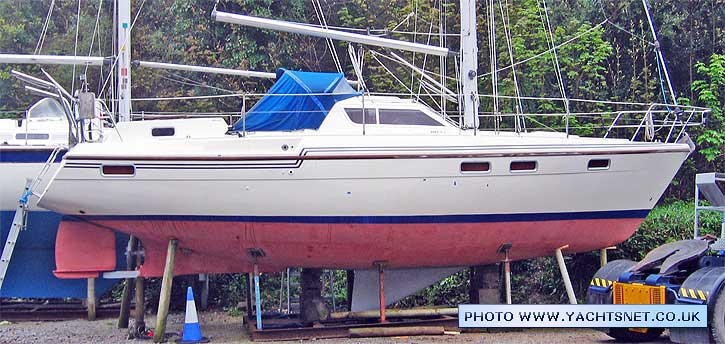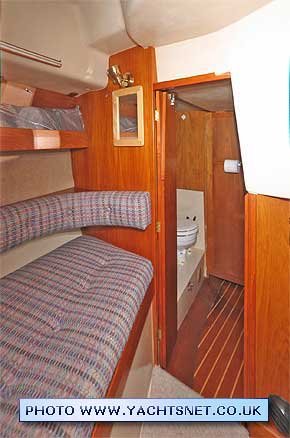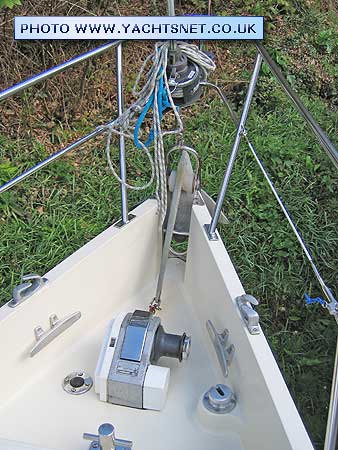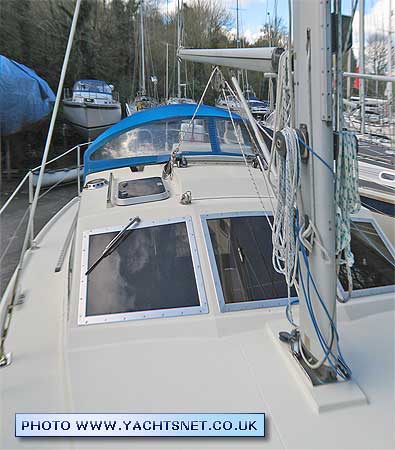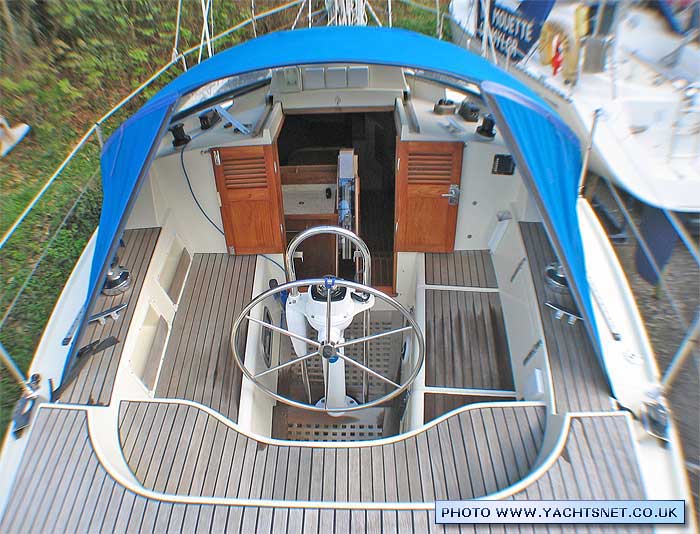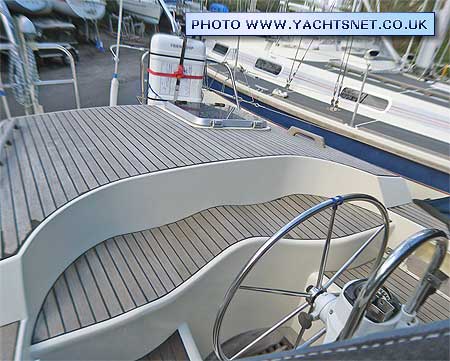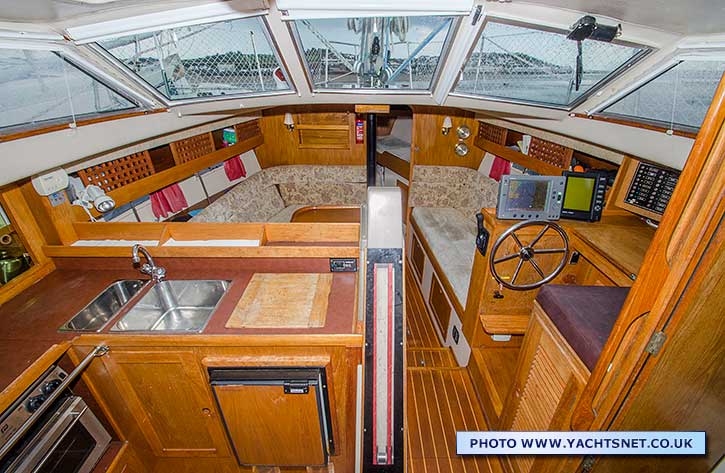 |
The earlier boats usually had a second internal wheel: later models saved a few inches
of saloon space by relying on an autohelm remote control at the chart table |
 |
 |
The accommodation starts with a forecabin with two over and
under 78" length single berths, with lots of light and ventilation.
There is dedicated storage above the berths for the extra leaf
for the saloon table, and the cushion to convert the U-shaped
dinette to a double berth.
Sailing performance on all the Southerly's has always been rated
as quite good - indeed surprisingly so for such a high-volume
hull with shallow draught. The one weakness of the single rudder
versions is that control can be difficult if driving the boat hard offwind in big quartering
seas, when the shallow rudder struggles to grip. Build quality
from Northshore was usually excellent.
The photo below shows the triangular drop keel and single rudder
of the Mk I Southerly 115s - the Mk II and III have a deeper drop
keel and twin rudders, to address the control problems in certain conditions of the original design.
|
 |
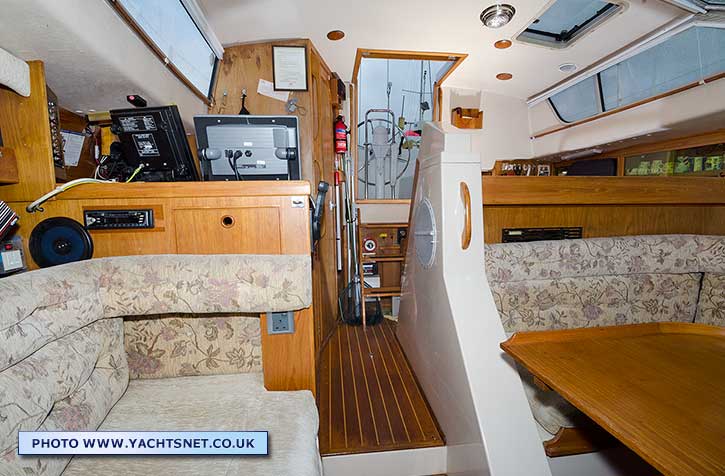 |
The saloon has the dinette to port and a single settee to starboard.
The table slides up (or down) the compression post to make a berth,
a dining area or up against the ceiling to open up the saloon for
entertaining. A second leaf (stowed in the forecabin) can be added
to make additional dining places. If used as a double berth the
dinette forms a 76" by 46" berth. |
Yachts seen here are no longer for sale - the data is online as a free information service for buyers researching boat types. THE PHOTOGRAPHS ARE COVERED BY COPYRIGHT, AND MAY NOT BE REPRODUCED WITHOUT THE PERMISSION OF YACHTSNET LTD.
Go to our brokerage
section for boats currently for sale |
|
To starboard by the companionway is the forward facing, sit-down
interior helm and navigation station. Interior steering on some boats is by
Autohelm control panel, rather than a wheel, which takes up too
much space. To port is the L shaped galley, with gimbaled cooker,
twin sinks, and refrigerated coolbox, again with plenty of storage,
including cleverly designed secure plate racks. Headroom is just
over six feet by the saloon table, increasing to about 6' 4"
by the nav station and galley.
|
|
 |
The galley is one of the best you will find on
a boat of this size. The keel box forms the side of the galley furniture,
and a clear panel in the aft end allows you to see the keel position
- here the keel is half down, as shown by the blocks with the blue
Spectra line being at the half-way mark |
Aft of the interior steering/navigation position is the forward
heads
|
 |
|
|
|
Aft of the galley is the passageway
to the aft cabin, which also provides very good engine room access.
To port of the passageway is the second heads compartment. The passageway
to the aft cabin is fairly low, but once in the aft cabin the headroom
is six feet.
|
 |
The aft cabin has a large double berth with a teak lee board
to starboard and a seat - which can also be used as a small berth
- to port. There are both opening and non-opening ports and a
large opening overhead hatch with a roll up sunscreen. There is
plenty of room to get dressed, with lots of storage. The double
berth is approx 78" by 52"
|
|
Yachts
seen here are no longer for sale - the data is online as
a free information service for buyers researching boat types.
THE PHOTOGRAPHS ARE COVERED BY COPYRIGHT, AND MAY NOT BE
REPRODUCED WITHOUT THE PERMISSION OF YACHTSNET LTD.
Go to our brokerage
section for boats currently for sale |
|
Engine access is good, from two large
hatches in the passageway to the aft cabin, and also a removable
panel under the companionway
|
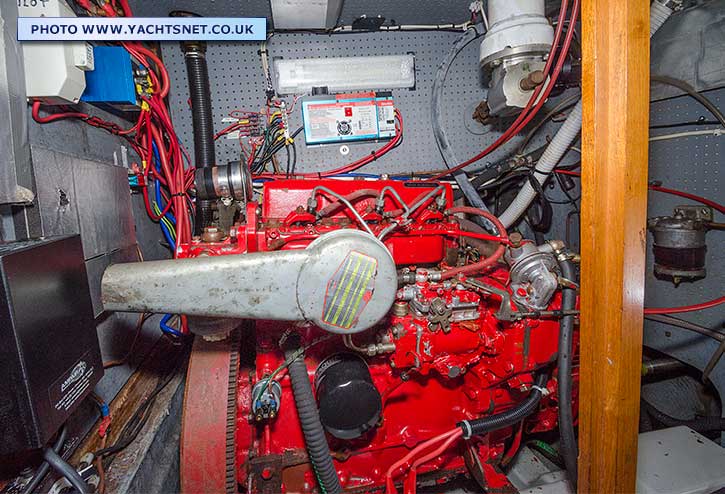 |
Yachts
seen here are no longer for sale - the data is online as a
free information service for buyers researching boat types.
THE PHOTOGRAPHS ARE COVERED BY COPYRIGHT, AND MAY NOT BE REPRODUCED
WITHOUT THE PERMISSION OF YACHTSNET LTD.
Go to our brokerage
section for boats currently for sale |
|
|
|
All the Southerlys have fixed ballast in the form
of a wide 'pancake' iron casting which acts as a grounding plate,
through which drops an aerofoil section cast iron swing keel, which
pivots on a stainless steel bearing, and is raised and lowered by
a hydraulic ram - in all but a few early boats this is powered by
an electrically driven pump, operated from the cockpit. There is
though a hand operated back-up. The keel can be locked up or down.
The photo at left shows the keel of a Mk I down with the yacht in slings |
The shallow rudder of these original generation Southerly 115s
is well protected against grounding by a substantial skeg and
heel plate. It does however give rise to the one criticism often
made of Southerlies - that in a quartering sea the rudder fails
to give enough control if the yacht is driven hard, and it is
better to reef to reduce heel angles. The twin rudders on the
Mk III were designed to improve this.
|
|
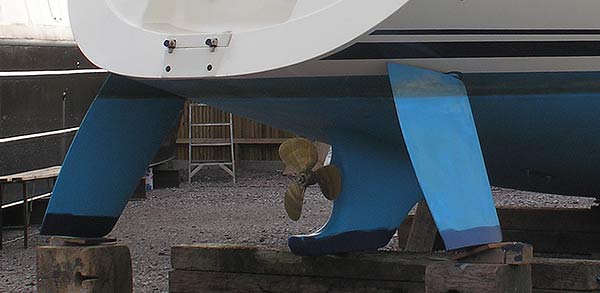 |
The later Southerly 115s had twin rudders generally similar to these rudders on a Southerly 110, and a redesigned and deeper lift keel |
|
On the Southerly 115 the fixed ballast is of
4,962 lbs, and the swing keel 2,016 lbs. With keel down the draught
is 6' 8" on the early triangular-keeled boats,a nd just over 8 ft on the later boats with keels as shown at right.
Despite this rather unconventional ballast arrangement,
Southerly 115s are now rated as RCD Category A, and have a remarkably
high AVS (angle of vanishing stability) of around 150 degrees -
far better than many other more conventional yachts. This is largely due to the large deckhouse providing buoyancy (provided the windows remain intact) at very high heel angles |
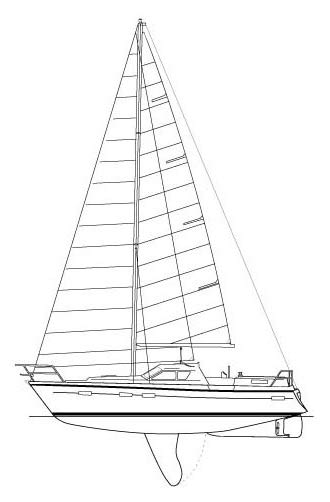
|
|
|
|




